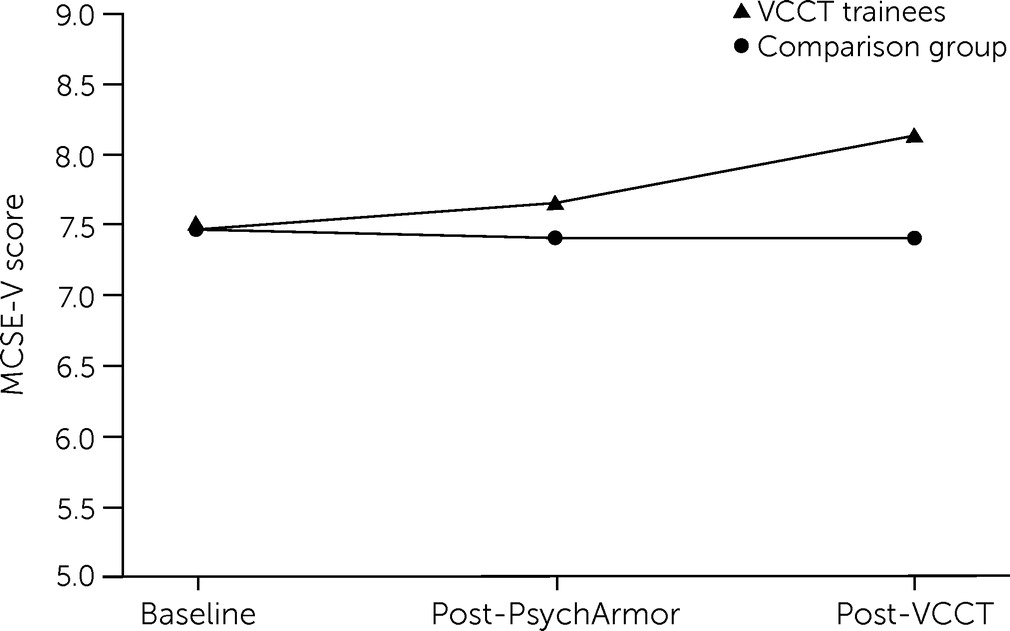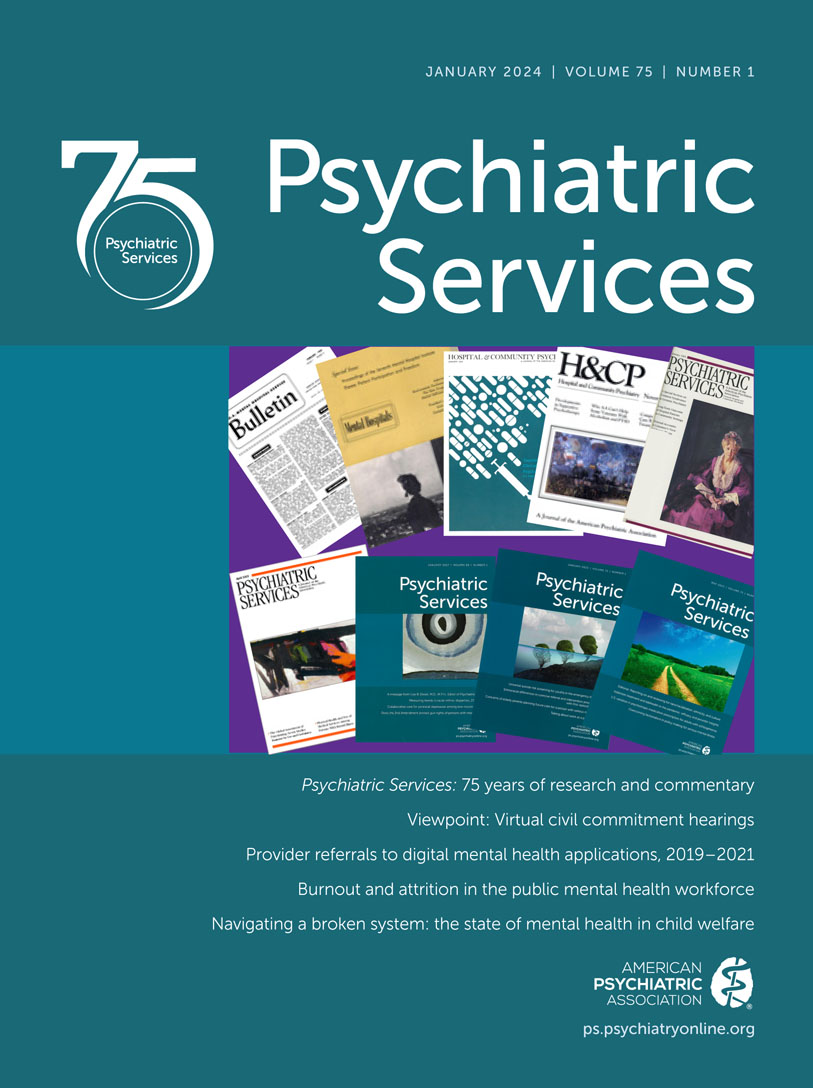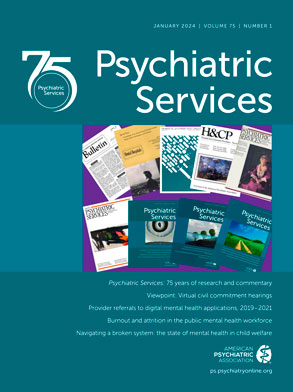Veteran Cultural Competence Training: Initial Effectiveness and National-Level Implementation
Abstract
Objective:
Methods:
Results:
Conclusions:
HIGHLIGHTS
Veteran Cultural Competence
Cultural Competence Training
Veteran Cultural Competence Training (VCCT)
Studying VCCT
Methods
Participants
Study 1.
Study 2.
| | Baseline | Post-VCCT | 1-month follow-up | ||||||
|---|---|---|---|---|---|---|---|---|---|
| Characteristic | MCSE-V score (M±SD) | N | % | MCSE-V score (M±SD) | N | % | MCSE-V score (M±SD) | N | % |
| Gender | | | | | | | | | |
| Man | 6.8±1.7 | 91 | 29 | 7.9±1.0 | 79 | 28 | 7.9±.9 | 58 | 32 |
| Woman | 5.9±2.0 | 221 | 71 | 7.7±1.1 | 200 | 72 | 7.7±1.0 | 125 | 68 |
| Veteran | | | | | | | | | |
| No | 5.8±1.9 | 239 | 77 | 7.5±1.1 | 216 | 77 | 7.6±.9 | 143 | 78 |
| Yes | 7.3±1.5 | 73 | 23 | 8.4±.7 | 63 | 23 | 8.4±.9 | 40 | 22 |
| Education level (degree) | | | | | | | | | |
| Associate’s, B.A., or B.S. | 6.2±2.1 | 115 | 37 | 7.9±1.0 | 104 | 37 | 7.9±.9 | 64 | 35 |
| Master’s | 6.2±1.9 | 152 | 49 | 7.8±1.1 | 141 | 51 | 7.7±1.1 | 89 | 49 |
| Doctoral | 5.7±1.6 | 45 | 14 | 7.2±1.4 | 34 | 12 | 7.7±.8 | 30 | 16 |
| Professional sector | | | | | | | | | |
| Health services | 6.1±1.9 | 144 | 46 | 7.7±1.1 | 125 | 45 | 7.7±1.0 | 82 | 45 |
| Social services | 6.5±1.8 | 89 | 29 | 7.8±1.1 | 80 | 29 | 7.9±1.0 | 51 | 28 |
| College faculty | 5.7±2.1 | 50 | 16 | 7.8±.9 | 47 | 17 | 7.8±.9 | 34 | 19 |
| Government or business | 6.1±2.4 | 29 | 9 | 7.3±1.3 | 27 | 10 | 7.7±1.2 | 16 | 9 |
| Total | 6.1±1.9 | 312 | 100 | 7.7±1.1 | 279 | 100 | 7.8±1.0 | 183 | 100 |
Measures
Study 1 Procedures
VCCT trainees.
Comparison group.
Study 2 Procedures
Study 2 Implementation Strategies
Preimplementation.
Implementation.
Sustainment.
RE-AIM
Data Analysis
Results
Study 1
| | Baseline | Post-PsychArmor online training | Post-VCCT | |||
|---|---|---|---|---|---|---|
| Parameter | β | SE | β | SE | β | SE |
| Difference in MCSE-V scores | | | | | | |
| Intercept | 7.51 | .04** | 7.48 | .07** | 7.45 | .11** |
| Groupb | −.10 | .05 | .27 | .11* | .63 | .27** |
| MCSE-V baseline score | .99 | .02** | .84 | .04** | .69 | .07** |
| Group × time interaction | | | | | | |
| Intercept | | | | | −.03 | .04 |
| Groupb | | | | | .37 | .09** |
| MCSE-V baseline score | | | | | −.15 | .04** |

Study 2
| | Baseline | Post-VCCT | 1-month follow-up | |||
|---|---|---|---|---|---|---|
| Parameter | β | SE | β | SE | β | SE |
| Difference in MCSE-V scores | | | | | | |
| Intercept | 6.66 | .29*** | 7.35 | .18*** | 8.03 | .20*** |
| Gendera | −.40 | .20* | −.10 | .13 | .21 | .14 |
| Veteran statusb | 1.29 | .21*** | 1.03 | .14*** | .76 | .15*** |
| Education levelc | −.12 | .15 | −.15 | .09 | −.17 | .10 |
| Partnership typed | −.08 | .14 | −.03 | .09 | .03 | .10 |
| N of training sessions (reference: 1 session) | −.05 | .11 | −.02 | .07 | .02 | .08 |
| Professional sectore | −.13 | .10 | −.10 | .06 | −.07 | .07 |
| Training approval authorityf | .21 | .61 | .01 | .38 | −.18 | .44 |
| Group × time interaction | | | | | | |
| Intercept | | | | | .69 | .17*** |
| Gendera | | | | | .31 | .11** |
| Veteran statusb | | | | | −.26 | .12* |
| Education levelc | | | | | −.03 | .08 |
| Partnership typed | | | | | .06 | .08 |
| N of training sessions (reference: 1 session) | | | | | .03 | .07 |
| Professional sectore | | | | | .03 | .06 |
| Training approval authorityf | | | | | −.19 | .37 |
Discussion
Conclusions
Supplementary Material
- View/Download
- 421.82 KB
REFERENCES
Information & Authors
Information
Published In
History
Keywords
Authors
Competing Interests
Metrics & Citations
Metrics
Citations
Export Citations
If you have the appropriate software installed, you can download article citation data to the citation manager of your choice. Simply select your manager software from the list below and click Download.
For more information or tips please see 'Downloading to a citation manager' in the Help menu.
View Options
View options
PDF/EPUB
View PDF/EPUBLogin options
Already a subscriber? Access your subscription through your login credentials or your institution for full access to this article.
Personal login Institutional Login Open Athens loginNot a subscriber?
PsychiatryOnline subscription options offer access to the DSM-5-TR® library, books, journals, CME, and patient resources. This all-in-one virtual library provides psychiatrists and mental health professionals with key resources for diagnosis, treatment, research, and professional development.
Need more help? PsychiatryOnline Customer Service may be reached by emailing [email protected] or by calling 800-368-5777 (in the U.S.) or 703-907-7322 (outside the U.S.).

